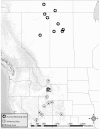Lead exposure in bald eagles from big game hunting, the continental implications and successful mitigation efforts
- PMID: 23284837
- PMCID: PMC3526477
- DOI: 10.1371/journal.pone.0051978
Lead exposure in bald eagles from big game hunting, the continental implications and successful mitigation efforts
Abstract
Studies suggest hunter discarded viscera of big game animals (i.e., offal) is a source of lead available to scavengers. We investigated the incidence of lead exposure in bald eagles in Wyoming during the big game hunting season, the influx of eagles into our study area during the hunt, the geographic origins of eagles exposed to lead, and the efficacy of using non-lead rifle ammunition to reduce lead in eagles. We tested 81 blood samples from bald eagles before, during and after the big game hunting seasons in 2005-2010, excluding 2008, and found eagles had significantly higher lead levels during the hunt. We found 24% of eagles tested had levels indicating at least clinical exposure (>60 ug/dL) during the hunt while no birds did during the non-hunting seasons. We performed driving surveys from 2009-2010 to measure eagle abundance and found evidence to suggest that eagles are attracted to the study area during the hunt. We fitted 10 eagles with satellite transmitters captured during the hunt and all migrated south after the cessation of the hunt. One returned to our study area while the remaining nine traveled north to summer/breed in Canada. The following fall, 80% returned to our study area for the hunting season, indicating that offal provides a seasonal attractant for eagles. We fitted three local breeding eagles with satellite transmitters and none left their breeding territories to feed on offal during the hunt, indicating that lead ingestion may be affecting migrants to a greater degree. During the 2009 and 2010 hunting seasons we provided non-lead rifle ammunition to local hunters and recorded that 24% and 31% of successful hunters used non-lead ammunition, respectively. We found the use of non-lead ammunition significantly reduced lead exposure in eagles, suggesting this is a viable solution to reduce lead exposure in eagles.
Conflict of interest statement
Figures




Similar articles
-
High risk of lead contamination for scavengers in an area with high moose hunting success.PLoS One. 2014 Nov 12;9(11):e111546. doi: 10.1371/journal.pone.0111546. eCollection 2014. PLoS One. 2014. PMID: 25389754 Free PMC article.
-
INFLUENCE OF SNOWFALL ON BLOOD LEAD LEVELS OF FREE-FLYING BALD EAGLES (HALIAEETUS LEUCOCEPHALUS) IN THE UPPER MISSISSIPPI RIVER VALLEY.J Wildl Dis. 2017 Oct;53(4):816-823. doi: 10.7589/2017-02-027. Epub 2017 Jul 28. J Wildl Dis. 2017. PMID: 28753412
-
The seasonal threat of lead exposure in bald eagles.Sci Total Environ. 2023 Sep 1;889:164256. doi: 10.1016/j.scitotenv.2023.164256. Epub 2023 May 19. Sci Total Environ. 2023. PMID: 37209742
-
Lead contamination in raptors in Europe: A systematic review and meta-analysis.Sci Total Environ. 2020 Dec 15;748:141437. doi: 10.1016/j.scitotenv.2020.141437. Epub 2020 Aug 8. Sci Total Environ. 2020. PMID: 32818895
-
Epidemiology of Great Lakes bald eagles.J Toxicol Environ Health. 1991 Aug;33(4):395-453. doi: 10.1080/15287399109531537. J Toxicol Environ Health. 1991. PMID: 1875429 Review.
Cited by
-
Health and Environmental Risks from Lead-based Ammunition: Science Versus Socio-Politics.Ecohealth. 2016 Dec;13(4):618-622. doi: 10.1007/s10393-016-1177-x. Epub 2016 Sep 23. Ecohealth. 2016. PMID: 27663438 Free PMC article. No abstract available.
-
High risk of lead contamination for scavengers in an area with high moose hunting success.PLoS One. 2014 Nov 12;9(11):e111546. doi: 10.1371/journal.pone.0111546. eCollection 2014. PLoS One. 2014. PMID: 25389754 Free PMC article.
-
Performance of lead-free versus lead-based hunting ammunition in ballistic soap.PLoS One. 2014 Jul 16;9(7):e102015. doi: 10.1371/journal.pone.0102015. eCollection 2014. PLoS One. 2014. PMID: 25029572 Free PMC article.
-
Reducing Lead on the Landscape: Anticipating Hunter Behavior in Absence of a Free Nonlead Ammunition Program.PLoS One. 2015 Jun 26;10(6):e0128355. doi: 10.1371/journal.pone.0128355. eCollection 2015. PLoS One. 2015. PMID: 26114878 Free PMC article.
-
Assessing multi-tissue lead burdens in free-flying obligate scavengers in eastern North America.Environ Monit Assess. 2017 Apr;189(4):139. doi: 10.1007/s10661-017-5855-0. Epub 2017 Mar 1. Environ Monit Assess. 2017. PMID: 28251454
References
-
- Fisher IJ, Pain DJ, Thomas VG (2006) A review of lead poisoning from ammunition sources in terrestrial birds. Biological Conservation 131: 421–432.
-
- Tranel MA, Kimmel RO (2009) Impacts of lead ammunition on wildlife, the environment, and human health - A literature review and implications for Minnesota. Proceedings of the Ingestion of Spent Ammunition: Implications for Wildlife and Humans Conference Pgs 318–337.
-
- Knopper L, Mineau P, Scheuhammer A, Bond D, McKinnon D (2006) Carcasses of shot Richardson’s ground squirrels may pose lead hazards to scavenging hawks. J of Wildl Mangmt 70: 295–299.
-
- Pauli JN, Buskirk SW (2007) Recreational shooting of prairie dogs: a portal for lead entering wildlife food chains. J of Wildl Mangmt 71: 103–108.
-
- Hunt WG, Burnham W, Parish C, Burnham K, Mutch B, et al. (2005) Bullet fragments in deer remains: implications for lead exposure in avian scavengers. Wildl Society Bull 33: 167–170.
Publication types
MeSH terms
Substances
LinkOut - more resources
Full Text Sources

